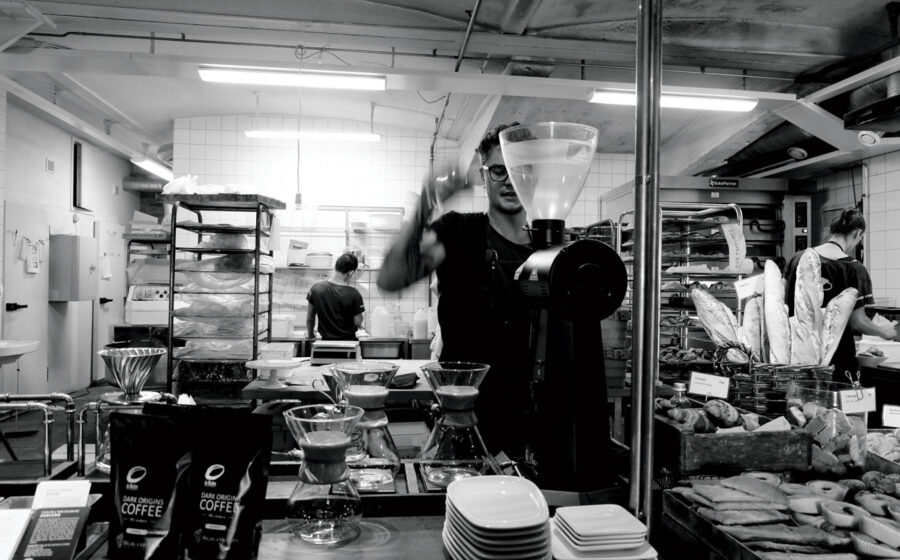[O]ne fateful afternoon in the early nineties, Matts Johansson had a life-altering experience. “I was in a small café in Gothenburg where I regularly sat, had a coffee, and watched the world go by. The other reason I went is that I was fascinated by the guy who ran the shop. He roasted the beans in the oven, just a normal, domestic, everyday oven, then put them through an espresso machine.”
While sipping the “surprisingly OK” result, Johansson, who worked as a chef, glanced over at a pile of coffee magazines. He opened one, and a coffee legend was born. “Looking through the features on roasting, coffee shops, and beans, I thought, ‘There’s a whole world out there.’ It was something I hadn’t even considered before.”
The seed was sown and, following a visit to San Francisco, Johansson was convinced he could have a future in coffee. “What really changed things for me was this great little independent café in the Castro. They were serving beautiful specialty coffee. At the same time, Starbucks was getting really popular. I could see there was a market, and if that was the case in the US, why not in Sweden?”
Johansson’s rationale for opening a café went like this: I like cafés; I’ve visited good ones all over the world; I’m a trained chef: why not open a coffee shop?
Well, one reason was economic meltdown on the Swedish side of the ocean. The country was in a financial crisis, and restaurants and hospitality businesses were going bankrupt left, right, and center. “The economy affected everything, all areas of the market. The old style cafés went, the posh places disappeared, too. And there wasn’t really a pub culture in Sweden, so basically we were left with no meeting places.” In short, there was a gap—or rather a huge, gaping hole in the market.
It didn’t matter to Johansson that he had no barista or even coffee shop experience. His rationale went like this: “I like cafés; I’ve visited good ones all over the world; I’m a trained chef: why not open a coffee shop? I had some savings—around 10,000 euros—and bought a place in Gothenburg near the university.”
That was in 1993. And with very little, if any, modern coffee culture to speak of and no one to learn the craft from, Johansson pretty much went it alone. Although he puts it more eloquently. “I was an autodidact. I’d watched baristas work, read what I could and had a rough idea of how to do it. I started using an espresso machine and initially my product was very much in the dark roast, Italian style. It worked because, at the time in Sweden, the classic Italian style was seen as cool and sophisticated.”
The thirty-seat shop, Caffe Espresso, was an immediate success, rapidly expanded, and became known for its lattes and espressos, an exotic rarity in Gothenburg. But Johansson didn’t rest on his laurels.
He sold the business in 1999 and went to Italy where he honed his craft. He visited machine factories and roasteries as well as countless cafés where he watched as baristas churned out beautifully crafted drinks.
“I was experiencing all these great products, but it occurred to me that there was no ‘right’ way to do things. I wanted to set out what made the perfect espresso.”
A rather lofty ambition you might think, penning the parameters of the beverage that defines a nation. But in 2000 he wrote Espresso Book and it became a bible for a generation of baristas. “It’s forgotten about now,” shrugs Johansson modestly, “But it was one of the first books to really define what went into a good drink.” The book was a sturdy foundation on which to build the World Barista Championships, which Johansson co-founded at the turn of the millennium.
“The idea was to lay down some rules and set standards for what was a rapidly growing industry. We defined how a cappuccino and espresso should be made, with pretty strict brew times, grinds, weight, and so on. At that time we felt it was necessary because the Italians, Aussies, Americans, and so on had such different ways of doing things.”
The original style had a distinctly Italian flavor.
“It made sense to do it the Italian way because they started the whole industry. Get the basics right then you can adapt and adjust. Being a chef, that was my philosophy. Looking back, we had to be strict. Having a focus was vital to the growth of the global market at that time, and the WBC had a huge impact.” So what now for the original custodian of the coffee code? First up, Johansson has plans to expand his chain of four nearly eponymous coffee shops. Nearly because they’re almost, but not quite, named after himself. “They’re called Da Matteo because when I was in Italy they found it difficult to say my name, so it kind of morphed into Matteo.”
And although Johansson started off on an Italian footing with his roasting style, nowadays he goes for what he calls medium roast. “Swedish coffee culture is still pretty young and a lot of people are used to a dark roasted product. So we try to get a balance which will ensure a good product whilst keeping the customers happy. The result is something comparatively light to retain the purer flavor, but not as light as for example in Norway.”
Trying to build up an appreciation for a superior product is something Johansson talks about in a slightly frustrated tone.
“We’re doing what we can in our cafés to talk to people about coffee and explain the differences between products but there’s an issue with the rest of the hospitality industry. Top-end restaurants will have the best wines and some great craft beer, but when it comes to coffee they don’t seem to care. I’ve talked to restaurant owners who tell me they use the machine they got free with the kitchen fit-out. Coffee isn’t a priority and that’s something that needs to change.”
Another hurdle for Johansson to overcome is Sweden’s fragmented market. There are a few high-end specialty joints like Da Matteo, chains such as the highly regarded Espresso House, but something of a void in between. So would Johansson consider working with a big player to create a quality product with more mass market appeal? “I’m a working class guy from a small village and you quickly understand what’s going on in the market and how you need to adapt. We want to grow, so yes, we would like to have an investor.
here is a precedent. Espresso House was the first coffee company to use private equity money and now they have 200 shops in Sweden, in Norway. It’s one of the best chains in Europe.”
So what does Johansson see as the future of Swedish coffee? “Our confidence is high and our self-perception is that we’re growing in importance in the worldwide industry.” Johansson then checks himself. “In reality though we’re still a small gamer.”
That’s selling the scene he helped create short, though. Sweden has long punched way over its weight of less than ten million citizens (just bigger than London). Without Sweden, and without Johansson, specialty coffee wouldn’t be what it is today.
—Elizabeth Hotson is a journalist based in London.
















